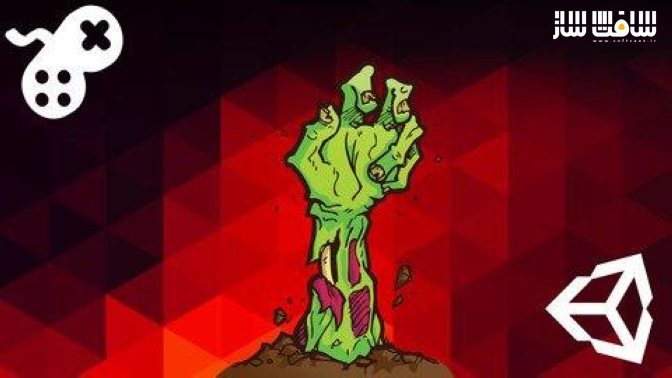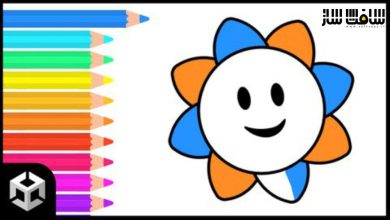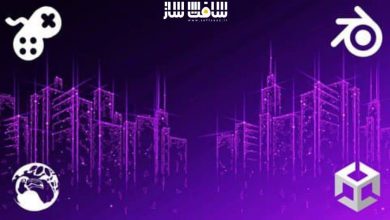آموزش توسعه کامل بازی اول شخص شوتر زامبی
Udemy - The Complete Unity Game Development Course

آموزش توسعه کامل بازی اول شخص شوتر زامبی
آموزش توسعه کامل بازی اول شخص شوتر زامبی : شروع به ساخت و توسعه بازی نباید یک کار ترسناک باشد. تنها چیزی که لازم دارید اشتیاق برای یادگیری و یک طبیعت کنجکاو برای ترکیب کد،انیمیشن ،گرافیک ، هوش مصنوعی ،هنر و صدا می باشد. یونیتی به دلیل سادگی و در عین حال توانایی های قدرتمندش،انتخاب اول هر بازی سازی می باشد.
در همه سیستم عامل ها کار میکند و به همه پلتفرم های مختلفی چون دسکتاپ،کنسول و گوشی موبایل اکسپورت شود. در این دوره از رابط کاربری یونیتی و ابزارهای گستر ده آن برای جمع آوری هنر،کد،طراحی و … برای تولید یک بازی کامل اول شخص شوتر زامبی از صفر استفاده می شود. این دوره آموزشی توسط تیم ســافــت ســاز برای شما عزیزان تهیه شده است.
عناوین اصلی دوره آموزشی :
- ایجاد و انیمیت یک کاراکتر اول شخص برای استفاده در FPS
- انیمیت مدلهای انسان نما و NPC
- تکنیک های هوش مصنوعی برای تعریف رفتار کاراکترهای غیر پلیر
- استفاده از سیستم ذرات برای شبیه سازی آتش،دود و خون
- استفاده از فیزیک برای توسعه یک مکانیک تیراندازی با انیمیشن های ag doll
- Unity’s Canvas جهت توسعه یک صفحه نمایش یکپارچه با مپ،رادار و قطب نما
- نحوه ایجاد آیتم های برداشتنی با کالیدر ها و تریگر ها
- افزودن موقعیت های چک پوینت برای ذخیره لوکیشن پلیر
- افزودن افکت های ویژه صوتی و بصری داینامیک
- سیستم Terrain Sculpting یونیتی برای توسعه مپ های بازی
- نحوه استفاده از نورپردازی برای بهبود محیط بازی
- تکنیک های پست پراسسینگ برای بهبود ظاهر محیط بازی
- نحوه ساخت یک بازی مستقل از یونیتی
عنوان دوره : Udemy – The Complete Unity Game Development Course
سطح : متوسط
زمان کل دوره : 20 ساعت
تعداد فایل های تصویری : 100
سال آموزش : 2020
فایل تمرینی : دارد
مربی دوره : Penny de Byl , Rob Percival
نرم افزار : Unity
زیرنویس انگلیسی : دارد
Udemy – The Complete Unity Game Development Course
The course begins with a section to introduce you to the Unity interface. If you are already familiar with Unity, you can skip to Section 3. In this introductory session, we will cover Unity’s window system, how to add models and textures, the creation of code to manipulate the properties of models, and the physics system.
Following this, we will start work on the First Person Character (FPC). You will learn how to add physics and code to move the character around, as well as add animated arms and a weapon that you can see in the game view. You will also work to add animations for firing and reloading the weapon. Audio effects for the player’s footsteps and jumping will also be included here.
Next, you will create pickup items for medical kits and ammunition that can be scattered around the game environment to provide extra resources to the player when their health or bullet levels get low. Here you will learn about how colliders and triggers can be used to fire off code to update values on the player that store an inventory.
We will then jump into the Unity Terrain Sculpting tool and work through the creation of a large game map on which to place the FPC and enemies. You will work with textures to colour the terrain and models, to add extra details such as trees and grass. High-quality models of houses, rocks, fences, and other props will be included for you to be as creative as you like in developing the game environment.
By this point, you’ll be ready to start adding the zombies. You will first begin with the zombie models and learn how to add animations to them and then move them about on the game environment using navigation meshes. Then we will cover one of the most popular artificial intelligence techniques used in games for creating simple behaviours in non-player characters; the Finite State Machine. You will develop enemies capable of wandering, chasing, attacking, dying, and standing idle. These actions will be linked to the location of the player such that the zombies will ignore the player when they are far away and only attack when in range.
Once these mechanics are in place, you will learn how to use raycasts to link the player’s shooting animations with a hit to the zombie. When hit, the zombie death animation will play and you will also be able to add in a ragdoll instead at this point. We will work with spotlights to create a crosshair aiming system and program dead zombies to sink into the ground, to remove them from the game.
Last but not least, we tie everything together with a Heads Up Display complete with health meter, an ammunition count, a radar for detecting nearby zombies, and a compass to point the player toward their goal location.
Once you have put all the game mechanics in place, you’ll learn several techniques for taking your game to a more professional level with special effects, extra audio & feedback, and a main menu switching system.
This is the perfect course to get started with Unity if you are an absolute beginner or learn a few extra techniques if you are familiar with the engine.
This course was created with Unity 2019.3.11f however is compatible with Unity 2019.4.2f1 (LTS) on either Mac or PC.
Learn how to code, animate, and work with:
The Unity Development Environment.
Unity’s C# interface.
Terrain Sculpting Tools for creating game maps.
First Person Characters and Animations for Walking, Shooting, and Reloading.
Pickup Items for Medical Kits and Ammunition.
3D Models of Zombies to add Animations for Walking, Chasing and Attacking.
An inventory system to keep track of player health and ammunition supplies.
Navigation Meshes for programming the movement of zombies and path planning on a terrain.
Finite State Machines for defining enemy A.I. behaviours.
Constructing Ragdoll models for dynamic death animations.
A Heads Up Display to inform the player of their health level and ammunition level, complete with a radar for locating zombies and a compass to guide the player home.
Special Effects such as fire, blood splatter, and lighting techniques.
Building the game to a standalone product.
All assets and incremental project files are included.
What you’ll learn
The Unity Game Engine Software
Creating and animating a first person character for use in an FPS
Animating humanoid models and NPCs
Artificial Intelligence techniques for defining the behaviour of non-player characters
Using particle systems to simulate fire, fog and blood
Using physics to develop a shooting mechanic with rag doll animations
Unity’s Canvas to develop an integrated heads up display with maps, radar and compass
How to create pickup items with colliders and triggers
Add position checkpoints to save player locations
Add dynamic visual and audio special effects
Unity’s Terrain Sculpting System for developing game maps
How to use lighting to enhance a game environment
Post Processing Techniques to enhance the look of a game environment
How to build a standalone game from Unity
دانلود با لینک مستقیم و سرعت بالا : 27 گیگابایت

برای دسترسی به کل محتویات سایت عضو ویژه سایت شوید
برای نمایش این مطلب و دسترسی به هزاران مطالب آموزشی نسبت به تهیه اکانت ویژه از لینک زیر اقدام کنید .
دریافت اشتراک ویژه
مزیت های عضویت ویژه :
- دسترسی به همه مطالب سافت ساز
- آپدیت روزانه مطالب سایت از بهترین سایت های سی جی
- ورود نامحدود کاربران از هر دیوایسی
- دسترسی به آموزش نصب کامل پلاگین ها و نرم افزار ها
اگر در تهیه اشتراک ویژه مشکل دارید میتونید از این لینک راهنمایی تهیه اشتراک ویژه رو مطالعه کنید . لینک راهنما
For International user, You can also stay connected with online support. email : info@softsaaz.ir telegram : @SoftSaaz
امتیاز به این مطلب :
امتیاز سافت ساز
لطفا به این مطلب امتیاز بدید 🦋





